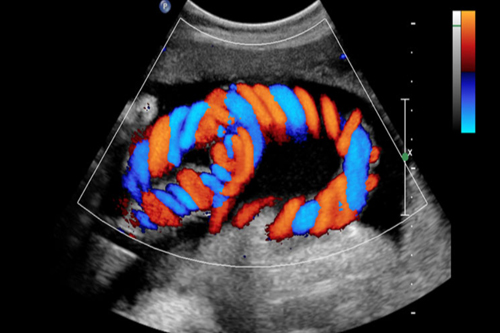Color Doppler

What is a Color Doppler ?
A Doppler ultrasound is a diagnostic imaging test utilizing sound waves to assess blood flow within your blood vessels. It can examine blood circulation in various parts of your body, including organs, neck, arms, and legs.
This type of ultrasound evaluates both arteries (which carry oxygen-rich blood from the heart and lungs to the body) and veins.
What is it used for?
Doppler ultrasound tests are utilized to diagnose blood flow issues in various parts of the body, including:
- Heart: A component of an echocardiogram, it assesses heart size, shape, and function, aiding in diagnosing conditions like narrowed or blocked arteries, aneurysms, heart valve diseases, and congenital heart defects.
- Arms and legs: It can detect conditions such as deep vein thrombosis (DVT), peripheral arterial disease (PAD), and varicose veins that affect blood flow.
- Neck and brain: Helps identify narrowed arteries, blood clots in the neck (carotid artery disease), and cerebral artery blockages that may lead to stroke.
- Abdomen: Used to examine blood flow in organs and detect aneurysms.
- New organ post-transplantation: Assesses normal blood flow through the organ.
Why do I need a Doppler ultrasound?
Doppler ultrasound may be necessary if you exhibit symptoms of abnormal blood flow, which vary depending on the affected body part and underlying cause.It may also be recommended if you:
- Have a high risk of stroke or have experienced a stroke or transient ischemic attack.
- Sustain an injury to your blood vessels.
- Experience high blood pressure potentially stemming from blocked arteries in the kidneys.
- Undergo treatment for a condition affecting blood flow to assess its efficacy.
- Are pregnant, particularly if there are concerns about fetal growth or specific health issues like high blood pressure or sickle cell disease.
What happens during a Doppler ultrasound?
During the procedure:
- You’ll be asked to remove clothing from the area under examination and lie on a table.
- The sonographer will apply a special gel onto your skin over the area to be examined.
- Using a wand-like device called a transducer, the sonographer will move it across your skin. While the device emits sound waves into your body, you won’t feel them.
- The sound waves bounce off red blood cells in your bloodstream.
- You may hear whooshing sounds as the ultrasound device captures echoes, converting them into images or graphs displayed on a computer screen.
- Once the exam is complete, the sonographer will clean the gel off your body.

